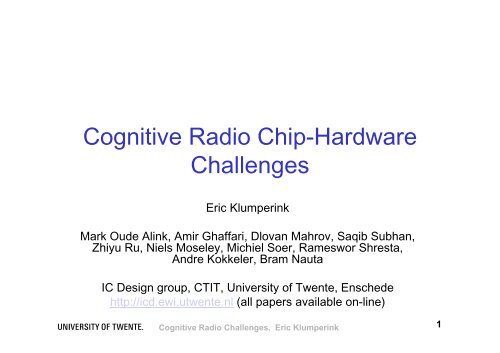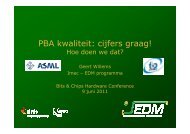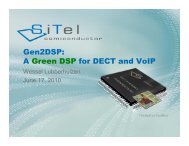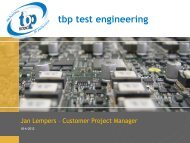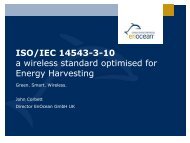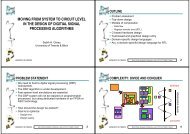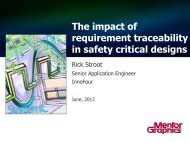Cognitive Radio Chip-Hardware Challenges - Hardware Conference
Cognitive Radio Chip-Hardware Challenges - Hardware Conference
Cognitive Radio Chip-Hardware Challenges - Hardware Conference
You also want an ePaper? Increase the reach of your titles
YUMPU automatically turns print PDFs into web optimized ePapers that Google loves.
<strong>Cognitive</strong> <strong>Radio</strong> <strong>Chip</strong>-<strong>Hardware</strong><br />
<strong>Challenges</strong><br />
Eric Klumperink<br />
Mark Oude Alink, Amir Ghaffari, Dlovan Mahrov, Saqib Subhan,<br />
Zhiyu Ru, Niels Moseley, Michiel Soer, Rameswor Shresta,<br />
Andre Kokkeler, Bram Nauta<br />
IC Design group, CTIT, University of Twente, Enschede<br />
http://icd.ewi.utwente.nl (all papers available on-line)<br />
<strong>Cognitive</strong> <strong>Radio</strong> <strong>Challenges</strong>, Eric Klumperink<br />
1
Overview<br />
• Introduction <strong>Cognitive</strong> <strong>Radio</strong> (CR)<br />
• <strong>Radio</strong> <strong>Hardware</strong> <strong>Challenges</strong> & Ideas<br />
• <strong>Cognitive</strong> <strong>Radio</strong><br />
• Flexible Receiver<br />
• Flexible Transmitter<br />
• Spectrum sensing<br />
• Conclusions<br />
<strong>Cognitive</strong> <strong>Radio</strong> <strong>Challenges</strong>, Eric Klumperink<br />
2
Static Frequency Allocation<br />
Almost all spectrum allocated - how find spectrum for mobile internet<br />
<strong>Cognitive</strong> <strong>Radio</strong> <strong>Challenges</strong>, Eric Klumperink<br />
3
Spectrum Allocated, but not in use!<br />
[Swisscom]<br />
<strong>Cognitive</strong> <strong>Radio</strong>: find & use “white spaces”<br />
<strong>Cognitive</strong> <strong>Radio</strong> <strong>Challenges</strong>, Eric Klumperink<br />
4
Applications<br />
more capacity more users, reliability, speed, ....<br />
Examples:<br />
• E.g. Broadband wireless access (IEEE 802.22)<br />
– 50-860 MHz (old TV-bands), Range: 17-30km<br />
• Reliable communication for Emergency Services<br />
other future<br />
applications ..<br />
<strong>Cognitive</strong> <strong>Radio</strong> <strong>Challenges</strong>, Eric Klumperink<br />
5
Overview<br />
• Introduction <strong>Cognitive</strong> <strong>Radio</strong> (CR)<br />
• <strong>Radio</strong> <strong>Hardware</strong> <strong>Challenges</strong> & Ideas<br />
• <strong>Cognitive</strong> <strong>Radio</strong> – Software Defined <strong>Radio</strong><br />
• Flexible Receiver – Clock Controlled Filter<br />
• Flexible Transmitter – Multi-path Architecture<br />
• Spectrum sensing – Mixed Signal X-correlator<br />
• Conclusions<br />
<strong>Cognitive</strong> <strong>Radio</strong> <strong>Challenges</strong>, Eric Klumperink<br />
6
<strong>Cognitive</strong> <strong>Radio</strong> <strong>Hardware</strong> Challenge<br />
Needed: Spectrum Sensor + Transmitter + Receiver<br />
Desired: flexibility<br />
– Frequency<br />
– Bandwidth<br />
– Modulation<br />
– ...<br />
“Software <strong>Radio</strong>”<br />
ADC<br />
DSP<br />
Analog-<br />
Digital<br />
Converter<br />
Digital<br />
Signal<br />
Processing<br />
How fast can we go<br />
DAC<br />
Digital-Analog<br />
Converter<br />
<strong>Cognitive</strong> <strong>Radio</strong> <strong>Challenges</strong>, Eric Klumperink<br />
7
ADC Bandwidth versus SNDR<br />
Frequency BW [Hz] [Hz]<br />
1,E+11<br />
1,E+10<br />
1,E+09<br />
1,E+08<br />
1,E+07<br />
1,E+06<br />
1,E+05<br />
<strong>Radio</strong> frequencies<br />
ISSCC 1997-2008<br />
VLSI 1997-2008<br />
ISSCC 2009<br />
VLSI 2009<br />
Jitter=1psrms<br />
Jitter=100fsrms<br />
1,E+04<br />
1,E+03<br />
10 20 30 40 50 60 70 80 90 100 110 120<br />
SNDR [dB]<br />
[Murmann, 2009]<br />
Is 40-50dB Signal to Noise-and-Distortion Range enough<br />
<strong>Cognitive</strong> <strong>Radio</strong> <strong>Challenges</strong>, Eric Klumperink<br />
8
How much Path Loss: “inverse square law”<br />
Antenna aperture<br />
~ (lambda/4) 2<br />
• Total power through sphere is constant<br />
• Received power in fixed area A reduces 1/R 2<br />
• Also less due to ground-reflection/multi-path: 1/R n with n~3<br />
10x more distances 1000x more power loss<br />
(10x power “10dB”, so 30dB per factor 10x distance)<br />
<strong>Cognitive</strong> <strong>Radio</strong> <strong>Challenges</strong>, Eric Klumperink<br />
9
Reduce path loss Parabolic antenna!<br />
+ Sensitivity<br />
- Big dish needed<br />
- Alignment needed, unpractical for mobile<br />
<strong>Cognitive</strong> <strong>Radio</strong> <strong>Challenges</strong>, Eric Klumperink<br />
10
Long distance large loss High SNDR<br />
SNDR<br />
• Assumptions for CR device: no antenna gain (non-directional)<br />
• Desired range for communication: at least e.g.1m..100m<br />
Result: Path loss ~ 10 … 70 dB + 10..30dB = 20..100dB<br />
(frequency-dependent 100MHz ..1GHz)<br />
6dB per ADC bit => >16 bits ADC needed<br />
<strong>Cognitive</strong> <strong>Radio</strong> <strong>Challenges</strong>, Eric Klumperink<br />
11
ADC Bandwidth versus SNDR<br />
BW [Hz]<br />
1,E+11<br />
1,E+10<br />
1,E+09<br />
1,E+08<br />
1,E+07<br />
1,E+06<br />
1,E+05<br />
1,E+04<br />
1,E+03<br />
10 20 30 40 50 60 70 80 90 100 110 120<br />
SNDR [dB]<br />
ISSCC 1997-2008<br />
VLSI 1997-2008<br />
ISSCC 2009<br />
VLSI 2009<br />
Jitter=1psrms<br />
Jitter=100fsrms<br />
<strong>Cognitive</strong> <strong>Radio</strong><br />
(6GHz and 100dB)<br />
[Murmann, 2009]<br />
<strong>Cognitive</strong> <strong>Radio</strong> <strong>Challenges</strong>, Eric Klumperink<br />
12
Downconversion / filtering required<br />
Resolution (bit)<br />
20<br />
16<br />
12<br />
8<br />
4<br />
1mW<br />
1 W<br />
1 kW<br />
1 W<br />
downconversion<br />
filter<br />
1kHz 1MHz 1GHz<br />
Signal Bandwidth (Hz)<br />
band<br />
filter<br />
Amplify<br />
f-shift<br />
(mixer)<br />
channel<br />
filter<br />
ADC +<br />
software<br />
“Software Defined <strong>Radio</strong>” if still very flexible through software<br />
<strong>Cognitive</strong> <strong>Radio</strong> <strong>Challenges</strong>, Eric Klumperink<br />
13
CR and SDR definitions by ITU<br />
• ITU = International Telecommunication Union<br />
• <strong>Cognitive</strong> <strong>Radio</strong> (CR):<br />
– Obtains knowledge from environment/user<br />
– Adjusts <strong>Radio</strong> parameters<br />
– Learns from results<br />
• Often a CR uses a Software Defined <strong>Radio</strong><br />
• Software Defined <strong>Radio</strong> (SDR):<br />
– Adjusts <strong>Radio</strong> parameter and protocols by software<br />
– At least frequency, modulation type, power<br />
– More flexible than predefined set by standard<br />
<strong>Cognitive</strong> <strong>Radio</strong> <strong>Challenges</strong>, Eric Klumperink<br />
14
Overview<br />
• Introduction <strong>Cognitive</strong> <strong>Radio</strong> (CR)<br />
• <strong>Radio</strong> <strong>Hardware</strong> <strong>Challenges</strong> & Ideas<br />
• <strong>Cognitive</strong> <strong>Radio</strong> – Software Defined <strong>Radio</strong><br />
• Flexible Receiver – Clock Controlled Filter<br />
• Flexible Transmitter – Multi-path Architecture<br />
• Spectrum sensing – Mixed Signal X-correlator<br />
• Conclusions<br />
<strong>Cognitive</strong> <strong>Radio</strong> <strong>Challenges</strong>, Eric Klumperink<br />
15
Mixer multiplication frequency shift<br />
sin<br />
f<br />
t<br />
sinf<br />
t sinf<br />
f t sinf<br />
f <br />
LO<br />
in<br />
LO<br />
in<br />
LO<br />
in<br />
t<br />
<br />
Downconversion<br />
(receiver)<br />
Upconversion<br />
(transmitter)<br />
f IN<br />
Difference and Sum<br />
frequencies<br />
f LO<br />
Lowpass<br />
Filter<br />
f LO -f IN<br />
Down-conversion<br />
f IN<br />
f LO<br />
Up-conversion<br />
f LO +f IN<br />
Band<br />
Filter<br />
<strong>Cognitive</strong> <strong>Radio</strong> <strong>Challenges</strong>, Eric Klumperink<br />
16
How implement RF band-filtering<br />
Q<br />
1<br />
R<br />
L/ C)<br />
AM-radio Receiver (1929):<br />
• Frequency selection by coil<br />
inductance L & capacitor C<br />
resonator, swing<br />
• Tuned mechanically by<br />
variable plate-capacitor C<br />
1<br />
center frequency : fc<br />
<br />
L C<br />
Now: fixed passive bandfilter<br />
(external SAW/BAW bandfilter)<br />
+ mixer with tunable frequency<br />
CMOS chip: limited Q=f c /bandwidth
Do we really need Filters Why<br />
Filter<br />
harmonics and<br />
much more ....<br />
2 3 4 5<br />
non-linearity!<br />
BB<br />
RF<br />
Filter<br />
Base Band (BB)<br />
ω<br />
(digital LO-generator)<br />
Time-variant BB<br />
to RF transfer!<br />
3 5<br />
But: good RF filters are costly and inflexible<br />
<br />
<strong>Cognitive</strong> <strong>Radio</strong> <strong>Challenges</strong>, Eric Klumperink<br />
3<br />
Can we implement suppression more flexibly<br />
5<br />
18
Flexible Integrated Filter Idea<br />
f S<br />
RC >> T on<br />
V in<br />
C 1 C 1<br />
average<br />
t<br />
V out<br />
C 1........<br />
C 1 ...<br />
C 4<br />
f S<br />
1.5f S<br />
0<br />
C 1 C 1<br />
[Franks, ISSCC 1960]<br />
“N-path filters”<br />
• High ohmic @ switching frequency<br />
• Short circuit @ other frequencies<br />
<strong>Cognitive</strong> <strong>Radio</strong> <strong>Challenges</strong>, Eric Klumperink<br />
19
Filter Properties<br />
Band-pass around f s<br />
Tunable (clock f s )<br />
High Q for high RCf s<br />
Good linearity & noise<br />
Unwanted harmonics<br />
V out / V in<br />
f S<br />
Frequency<br />
V out<br />
More paths Less Distortion<br />
<strong>Cognitive</strong> <strong>Radio</strong> <strong>Challenges</strong>, Eric Klumperink<br />
20
Filter Properties: flexibly tunable<br />
Selectivity (Q)<br />
Compression (P 1dB<br />
)<br />
Linearity (IIP3)<br />
Noise Figure<br />
3 to 29<br />
+2dBm<br />
+19dBm<br />
Overview<br />
• Introduction <strong>Cognitive</strong> <strong>Radio</strong> (CR)<br />
• <strong>Radio</strong> <strong>Hardware</strong> <strong>Challenges</strong> & Ideas<br />
• <strong>Cognitive</strong> <strong>Radio</strong> – Software Defined <strong>Radio</strong><br />
• Flexible Receiver – Clock Controlled Filter<br />
• Flexible Transmitter – Multi-path Architecture<br />
• Spectrum sensing – Mixed Signal X-correlator<br />
• Conclusions<br />
<strong>Cognitive</strong> <strong>Radio</strong> <strong>Challenges</strong>, Eric Klumperink<br />
22
<strong>Cognitive</strong> <strong>Radio</strong> Transmitter<br />
Current Dream: One multi-band Flexible transmitter Upconverter<br />
LO<br />
PA<br />
Filter<br />
BB<br />
Signal<br />
LO<br />
PA<br />
Filter<br />
LO<br />
PA<br />
Filter<br />
<strong>Cognitive</strong> <strong>Radio</strong> <strong>Challenges</strong>, Eric Klumperink<br />
23
Multipath Polyphase Technique<br />
Divide the nonlinear circuit into ‘N’ equal smaller pieces<br />
Nonlinear<br />
circuit<br />
Nonlinear<br />
circuit<br />
Nonlinear<br />
circuit<br />
Nonlinear<br />
circuit<br />
<strong>Cognitive</strong> <strong>Radio</strong> <strong>Challenges</strong>, Eric Klumperink<br />
24
Multipath Polyphase Technique (2)<br />
Add equal but opposite phase shift before and after<br />
Use equidistant phases: path i uses i*2π/N<br />
path i=1<br />
0×2π/N<br />
Nonlinear<br />
circuit<br />
-0×2π/N<br />
y 1<br />
x(t)<br />
path i=2<br />
1×2π/N<br />
Nonlinear<br />
circuit<br />
-1×2π/N<br />
y(t)<br />
y 2<br />
y N<br />
path i=N<br />
Nonlinear<br />
circuit<br />
( N-1)×2π/N -(N-1)×2π/N<br />
<strong>Cognitive</strong> <strong>Radio</strong> <strong>Challenges</strong>, Eric Klumperink<br />
25
Example: Output for 3-Path case<br />
Phase rotation increases with order of nonlinearity/harmonic:<br />
y 3<br />
y<br />
120<br />
120<br />
1 y 2 y 3 y 1<br />
y 1<br />
y 1 y 2 y 3<br />
0<br />
y 0<br />
0<br />
0<br />
3<br />
y 2<br />
Fundamental<br />
(y x)<br />
Magnitude:<br />
A<br />
240<br />
y 2<br />
2 nd Harmonic<br />
(y x 2 )<br />
240<br />
3 rd Harmonic<br />
(y x 3 )<br />
First non-cancelled<br />
Harmonic<br />
4 th Harmonic<br />
(y x 4 )<br />
2 3 4 5 6<br />
<strong>Cognitive</strong> <strong>Radio</strong> <strong>Challenges</strong>, Eric Klumperink<br />
26
N-PATH: First Non-cancelled Component<br />
A<br />
2 Path<br />
A<br />
3 Path<br />
A<br />
4 Path<br />
A<br />
‘N’ Path<br />
2 3 4 5 6<br />
2 3 4 5 6<br />
2 3 4 5 6<br />
2 3 4 5 (N+1)<br />
(N+1) th<br />
Harmonic<br />
Multi-tone input: cancels p· 1 ± q· 2 , except if: p+q=j×N+1<br />
<strong>Cognitive</strong> <strong>Radio</strong> <strong>Challenges</strong>, Eric Klumperink<br />
27
Concept of Flexible Transmitter<br />
BB<br />
path i=1<br />
Digital baseband<br />
phase shifters:<br />
0×2π/N<br />
path i=2<br />
1×2π/N<br />
Nonlinear<br />
circuit<br />
Nonlinear<br />
circuit<br />
Analog up-mixers<br />
with different phases<br />
LO<br />
LO<br />
0<br />
-2π/N<br />
y 1<br />
y 2<br />
y N<br />
-(N-1)×2π/N<br />
path i=N<br />
(N-1)×2π/N<br />
Nonlinear<br />
circuit<br />
LO<br />
[Shrestha et al, JSSC 2006]<br />
<strong>Cognitive</strong> <strong>Radio</strong> <strong>Challenges</strong>, Eric Klumperink<br />
28
Cancelling Harmonics/Sidebands<br />
1-path Desired signal, LO + BB LLO ±B BB<br />
Power<br />
18-path<br />
Power<br />
Desired signal<br />
3 LO +3 BB<br />
(3=0×18+3)<br />
Non-cancelled terms<br />
L=j×N+B<br />
17 LO - BB<br />
j=…-2,-1,0,1,2,…<br />
15 LO -3 BB<br />
(15=1×18-3)<br />
1 3 5 7 9 11 13 15 17<br />
[Shresta et al, JSSC 2008]<br />
/ LO<br />
29<br />
<strong>Cognitive</strong> <strong>Radio</strong> <strong>Challenges</strong>, Eric Klumperink
Overview<br />
• Introduction <strong>Cognitive</strong> <strong>Radio</strong> (CR)<br />
• <strong>Radio</strong> <strong>Hardware</strong> <strong>Challenges</strong> & Ideas<br />
• <strong>Cognitive</strong> <strong>Radio</strong> – Software Defined <strong>Radio</strong><br />
• Flexible Receiver – Clock Controlled Filter<br />
• Flexible Transmitter – Multi-path Architecture<br />
• Spectrum sensing – Mixed Signal X-correlator<br />
• Conclusions<br />
<strong>Cognitive</strong> <strong>Radio</strong> <strong>Challenges</strong>, Eric Klumperink<br />
30
Spectrum Sensing: shadowing problem<br />
C does not detect A due to “shadowing” of building<br />
need for sensing below noise floor<br />
<strong>Cognitive</strong> <strong>Radio</strong> <strong>Challenges</strong>, Eric Klumperink<br />
31
Linearity vs Noise<br />
Ideal output = actual input ( ) spectrum<br />
Difference 80dB<br />
<strong>Cognitive</strong> <strong>Radio</strong> <strong>Challenges</strong>, Eric Klumperink<br />
32
Linearity vs Noise<br />
Effect of non-linearity (too strong signals):<br />
(NF=20dB, IIP3=+10dBm, RBW=100kHz, att.=0dB)<br />
<strong>Cognitive</strong> <strong>Radio</strong> <strong>Challenges</strong>, Eric Klumperink<br />
33
Linearity vs Noise<br />
Apply attenuation: distortion OK but too much noise<br />
(NF=20dB, IIP3=+10dBm, RBW=100kHz, att.=48dB)<br />
Each dB of attenuation:<br />
- Noise floor up by 1dB<br />
- Distortion peaks down by 2dB<br />
<strong>Cognitive</strong> <strong>Radio</strong> <strong>Challenges</strong>, Eric Klumperink<br />
34
f test<br />
[Oude Alink et al, DySPAN 2010]<br />
Idea to improve Spectrum Analysis<br />
Idea to “get rid of the noise”:<br />
– a) Duplicate receiver<br />
– b) Cross-correlate outputs<br />
Result: correlated signal (and noise)<br />
Atten. ADC FFT<br />
out<br />
f test<br />
X-corr<br />
out<br />
Atten. ADC FFT<br />
<strong>Cognitive</strong> <strong>Radio</strong> <strong>Challenges</strong>, Eric Klumperink<br />
35
Cross-correlation measurement<br />
Normalized Measurement Time=2 0<br />
23<br />
45<br />
67<br />
89<br />
10 11 12 13 14<br />
test tone<br />
RBW=10kHz<br />
-100dBm<br />
DC-offset<br />
<strong>Cognitive</strong> <strong>Radio</strong> <strong>Challenges</strong>, Eric Klumperink<br />
36
XCSA: Measurements III<br />
RBW=10kHz<br />
signal not<br />
visible with<br />
autocorrelation<br />
more accurate<br />
amplitude estimation<br />
NF=17.1dB<br />
NF=3.1dB<br />
<strong>Cognitive</strong> <strong>Radio</strong> <strong>Challenges</strong>, Eric Klumperink<br />
37
Conclusions<br />
CR,SDR hardware less fixed analog filters<br />
stronger interference, nonlinearity, ...<br />
Ideas to address challenges:<br />
Clock controlled switched RC-filter<br />
Cancel via Multipath Polyphase transmitter<br />
Exploit mixed-signal cross-correlation<br />
<strong>Cognitive</strong> <strong>Radio</strong> <strong>Challenges</strong>, Eric Klumperink<br />
38
Questions<br />
<strong>Cognitive</strong> <strong>Radio</strong> <strong>Challenges</strong>, Eric Klumperink<br />
39


